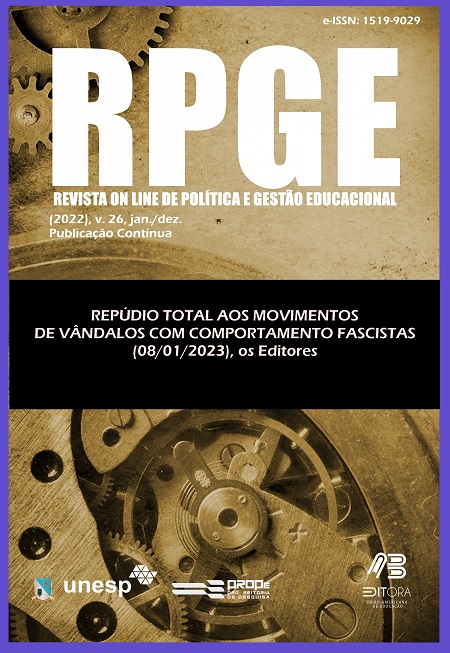Maneiras de fazer música de conjunto e orquestra por clarinetistas como tecnologias pedagógicas
DOI:
https://doi.org/10.22633/rpge.v26i00.16466Palavras-chave:
Características antropométricas, Velocistas, Jumpers, Atletismo, EducaçãoResumo
A pesquisa trata do problema pedagógico do uso do fazer musical coletivo. Os resultados da avaliação da observação pedagógica em duas turmas de alunos do 1º ano da universidade de música foram utilizados como materiais de investigação. A amostra representativa foi composta por 75 alunos selecionados por amostragem mecânica. A metodologia de pesquisa inclui os métodos de grupo científico geral, e os métodos especiais: análise de conteúdo da literatura científica, o método de observação pedagógica incluído, o método de análise estatística usando o programa de análise avançada Neural Designer. Em conclusão, a introdução de um conjunto educativo e de uma orquestra no processo de aprendizagem do clarinete torna possível enriquecer a experiência musical-teórica e prática performativa dos alunos de clarinete, para maximizar o repertório de concertos de gênero-temático, técnico, educativo e artístico de clarinetistas, para formar nos participantes do conjunto educacional experimental o pensamento variante analítico e a capacidade de tomar uma decisão única de interpretação e performance.
Downloads
Referências
APRIAMOV, V. M. Methodical bases of music-making of clarinetists in an ensemble. South Russian Musical Almanac, v. 2, p. 83-96, 2017.
BATTIPAGLIA, V. A. The double-lip embouchure in clarinet playing. Journal of New Music Research, n. 49, n. 8, p. 36-49, 2019.
BORODINA, T. I. The role of the chamber ensemble in the education of performing musicians. Bulletin of the Tambov University. Series: Humanities, v. 4, p. 10-25, 2017.
ELLSWORTH, J. The Clarinet. Routledge, 2021. 308 p.
FROLOVA, N. A. The Pedagogical Potential of Modern Auto-didactics in the Process of Performing Training of Music Students. Siberian Pedagogical Journal, v. 1, p. 2-7, 2015.
GABRIEL, J. D.; COYLE, W. L. A method for automatic detection of tongued and slurred note transitions in clarinet playing. The Journal of the Acoustical Society of America, v. 146, n. 3, p. 238-244, 2019.
GABRIEL, J. D.; COYLE, W. L. Detecting articulations in clarinet playing. The Journal of the Acoustical Society of America, v. 145, n. 3, p. 1677-1689, 2019.
GORDEYEVA, E. V. The Practice of Ensemble Music-Making and the Baroque Clavier Musical Text. ICONI, n. 1, p.135-149, 2019.
HINTON, J. T. The clarinet (a teachers’ and students’ guide to the clarinet and clarinet playing). The world of science, culture, education, v. 6, p. 17-26, 2021.
KAMINSKAYA, E. A.; DEDOV, S. V. Music-making in a mixed ensemble as a pedagogical problem. The world of science, culture, education, v. 6, p. 187-190, 2021.
LAWRENCE, S. L. The status of the American school of clarinet playing. In book: BBC Music micro-bit Recipes, p. 247-275, 2021.
MINI, Z. The national style of variations on the themes of Subei for clarinet and piano by Zhang Wu in the context of Chinese composer’s creativity in 1949-1966. Manuscript, v. 10, p. 3-14, 2021.
NORTH, V. M. A handbook of suggestions for solutions to problems of beginners in clarinet playing. Journal of New Music Research, v. 52, n. 12, p. 16-28, 2020.
OLMOS, A.; BOUILLOT, N. A High-Fidelity Orchestra Simulator for Individual Musicians’ Practice. Computer Music Journal, v. 36, n. 2, p. 55-73, 2020.
PÀMIES-VILÀ, M.; HOFMANN, A. The influence of the vocal tract on the attack transients in clarinet playing. Journal of New Music Research, v. 49, n. 4, p. 1-10, 2020.
RASH B. In discussion: the clarinetists of Chineka. The Clarinet, v. 47/4, p. 32-49, 2020.
RYBALKO, E. A. Collective music-making as one of the directions of general musical education. Manuscript, v. 10, p. 15-21, 2021.
SCOTT, S. J. Playing Musical Instruments: A Resource for Teachers. In: Music Education for Children with Autism Spectrum Disorder. 2020. p. 169-210.
SERKOV, K. S. Playing in an ensemble as the most important component of learning to play wind instruments. Bulletin of musical science, v. 1, p. 151-157, 2020.
SLIS, A.; WOLAK, K.; NAMASIVAYAM, A. An exploratory study into different types of articulation in clarinet playing. A comparative analysis of tongue action in single-, double, and side-to-side staccato articulation types on the clarinet. 2017. 206 p.
STEPENKO, E. A. Constructive Interaction of Teacher and Student in the Process of Learning to Play the Clarinet as a Condition for Formation of Ensemble Music Culture. Uchenye Zapiski RGSU, v. 20, n. 2, p. 139-147, 2021.
TAILLARD, T. A. Theoretical and experimental study of the role of the reed in clarinet playing. Etude théorique et expérimentale du rôle de l'anche dans le jeu de la clarinette, v. 3, p. 27-39, 2018.
WEISS, A. E.; NUSSECK, M.; SPAHN, C. Motion types of ancillary gestures in clarinet playing and their influence on the perception of musical performance. Journal of New Music Research, v. 47, n. 6, p. 1-14, 2018.
YU, Z. Some milestones in the historical evolution of the clarinet: on the way to world fame. South Russian Musical Almanac, v. 2, p. 78-82, 2017.
ZAGURSKY, V. I. Vocal-ensemble component in the preparation of a musician: technological processes and creative principles. Scientific notes of the Crimean Federal University named after V. I. Vernadsky. Sociology. Pedagogy. Psychology, v. 3, p. 102-126, 2021.
Downloads
Publicado
Como Citar
Edição
Seção
Licença
Copyright (c) 2022 Revista on line de Política e Gestão Educacional

Este trabalho está licenciado sob uma licença Creative Commons Attribution-NonCommercial-ShareAlike 4.0 International License.
Manuscritos aceitos e publicados são de propriedade da Revista on line de Política e Gestão Educacional. É vedada a submissão integral ou parcial do manuscrito a qualquer outro periódico. A responsabilidade do conteúdo dos artigos é exclusiva dos autores. É vedada a tradução para outro idioma sem a autorização escrita do Editor ouvida a Comissão Editorial Científica.











